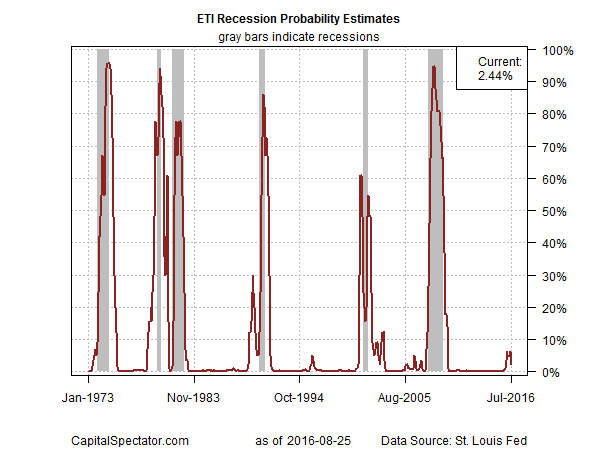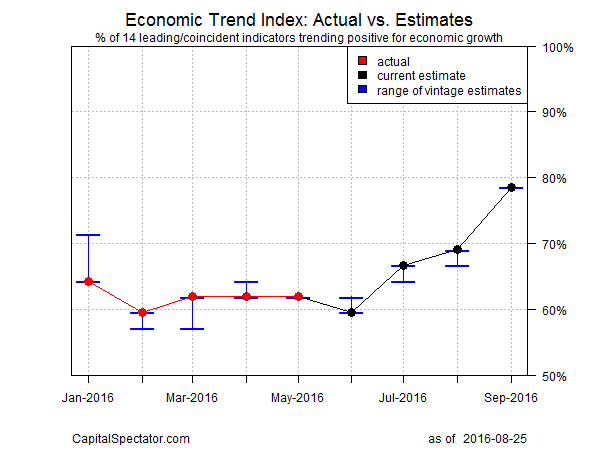US economic growth continues to rebound after a soft patch in the first half of the year. Supported by stronger job growth in June and July, the firmer trend in the actual data follows projections published by The US Business Cycle Risk Report and The Capital Spectator in previous months for a revival in the pace of the expansion (see the bottom charts here and here, for example). The recovery is expected to strengthen in the months ahead, as summarized in today’s update, as shown in the last chart at the bottom of this post.
The bounce in economic activity is also showing up in other sources, including recent nowcasts for third-quarter GDP from two Federal Reserve banks. The New York Fed’s Aug. 19 estimate for Q3 GDP growth is 3.0% and the Atlanta Fed’s GDPNow model is projecting a 3.6% rise as of Aug. 16. In both cases, the expected increase in output marks a substantial improvement over Q2’s weak 1.2% advance (seasonally adjusted annual rate).
Meantime, the actual data published to date is showing signs of recovering from the deceleration in growth in the first half of the year. The Economic Trend and Momentum indices (ETI and EMI, respectively) ticked higher in July, reflecting levels that equate with moderately firmer growth. As a result, recession risk remains low and is expected to remain so for the near term. The analysis is based on a methodology outlined in Nowcasting The Business Cycle: A Practical Guide For Spotting Business Cycle Peaks. Here’s a summary of recent activity for the components of ETI and EMI:
Aggregating the current data in the table above into business cycle indexes reflects slightly firmer trends overall. The latest numbers for ETI and EMI show that both benchmarks are above their respective danger zones: 50% for ETI and 0% for EMI. When or if the indexes fall below the tipping points, we’ll have clear warning signs that recession risk is at a critical level and a new downturn is likely. (See note at the end of this post for ETI/EMI design rules.)
Translating ETI’s historical values into recession-risk probabilities via a probit model also points to low business-cycle risk for the US through last month. Analyzing the data with this methodology shows a slight uptick in risk lately, but the numbers still imply that the odds are low that the National Bureau of Economic Research (NBER) — the official arbiter of US business cycle dates— will declare July as the start of a new recession.
For perspective on looking ahead, consider how ETI may evolve as new data is published. One way to project future values for this index is with an econometric technique known as an autoregressive integrated moving average (ARIMA) model, based on calculations via the “forecast” package for R, a statistical software environment. The ARIMA model calculates the missing data points for each indicator, for each month–in this case through September 2016. (Note that May 2016 is currently the latest month with a complete set of published data.) Based on today’s projections, ETI is expected to remain above its danger zone for the near term by holding above the 50% mark. (Keep in mind that business cycle updates are available on a weekly basis in The US Business Cycle Risk Report.)
Forecasts are always suspect, of course, but recent projections of ETI for the near-term future have proven to be relatively reliable guesstimates vs. the full set of published numbers that followed. That’s not surprising, given the broadly diversified nature of ETI. Predicting individual components, by contrast, is prone to far more uncertainty. The current projections (the four black dots on the right in the chart above) suggest that the economy will continue to expand and strengthen. The chart above also includes the range of vintage ETI projections published on these pages in previous months (blue bars), which you can compare with the actual data that followed, based on current numbers (red dots). The assumption here is that while any one forecast for a given indicator will likely miss the mark, the errors may cancel out to some degree by aggregating a broad set of predictions. That’s a reasonable view according to the historical record for the ETI forecasts.
For additional perspective on judging the track record of the forecasts, here are the previous updates for the last three months:
20 Jul 2016
20 Jun 2016
18 May 2016
Note: ETI is a diffusion index (i.e., an index that tracks the proportion of components with positive values) for the 14 leading/coincident indicators listed in the table above. ETI values reflect the 3-month average of the transformation rules defined in the table. EMI measures the same set of indicators/transformation rules based on the 3-month average of the median monthly percentage change for the 14 indicators. For purposes of filling in the missing data points in recent history and projecting ETI and EMI values, the missing data points are estimated with an ARIMA model.




Pingback: Bear Market Risk Signals - TradingGods.net